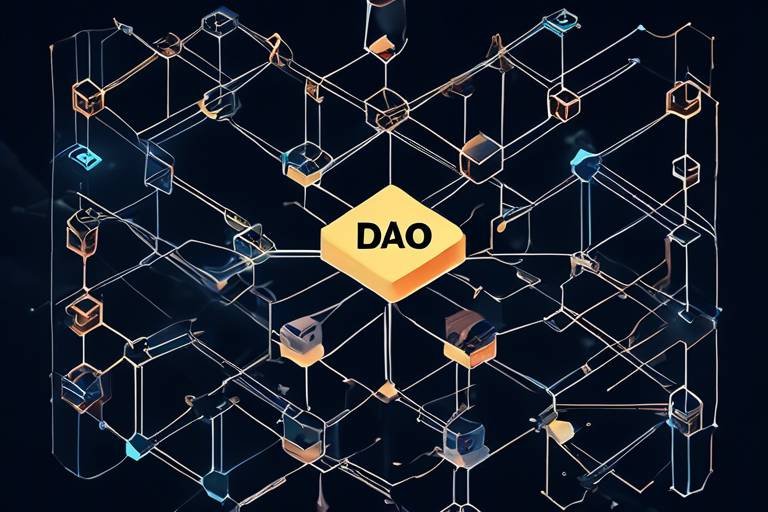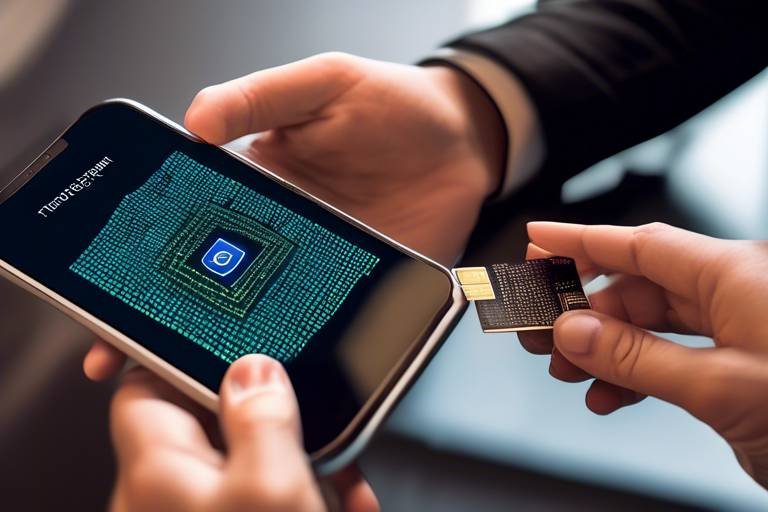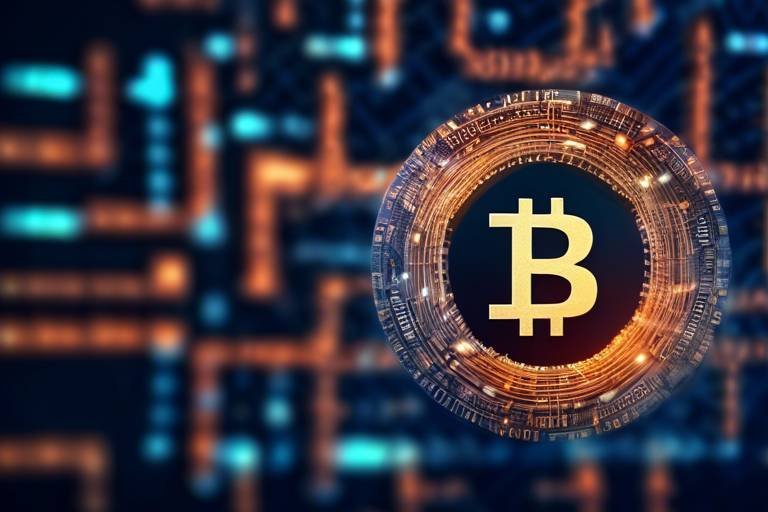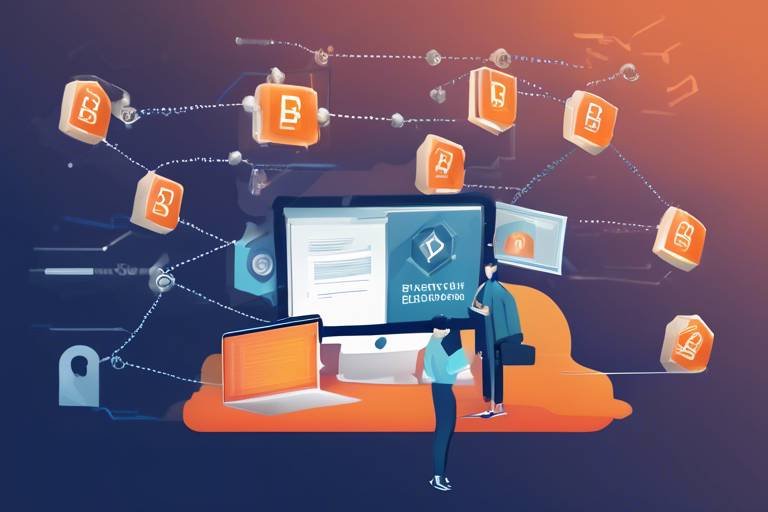How Blockchain Can Facilitate Employee Engagement and Rewards
In today's fast-paced corporate world, keeping employees engaged and motivated is more crucial than ever. Traditional reward systems often fall short, leading to dissatisfaction and disengagement. Enter blockchain technology, a revolutionary solution that not only enhances transparency but also fosters trust and efficiency in employee engagement and reward systems. Imagine a workplace where every contribution is recognized, where rewards are distributed fairly, and where employees feel genuinely valued. Sounds like a dream, right? Well, with blockchain, this dream is becoming a reality.
Blockchain operates as a decentralized ledger, which means that it records transactions across multiple computers in such a way that the registered transactions cannot be altered retroactively. This characteristic is essential for creating a transparent and secure environment. By leveraging blockchain, organizations can ensure that every employee's contributions are documented and rewarded accurately, thus creating a more engaged workforce. This isn't just about technology; it's about transforming the workplace culture into one that prioritizes recognition and fairness.
But how exactly does blockchain achieve this? To start with, it enhances transparency in reward systems. Employees can see how rewards are distributed and earned, fostering a sense of trust and motivation. Imagine walking into a workplace where you can track your achievements and understand how they translate into rewards. This transparency can significantly boost morale and encourage employees to put forth their best efforts.
Moreover, blockchain enables the use of smart contracts, which automate reward distribution based on predefined criteria. This means that as soon as an employee meets a specific goal, their reward is automatically processed without any delays or bureaucratic hurdles. This not only improves satisfaction but also reinforces the idea that hard work is recognized and rewarded promptly. In a world where instant gratification is the norm, this feature can significantly enhance employee engagement.
Tracking individual contributions is another area where blockchain shines. By utilizing this technology, organizations can ensure that every employee's efforts are acknowledged. When employees feel valued and recognized for their hard work, they are more likely to be engaged and committed to their roles. It's similar to a sports team; when each player knows their contributions are essential for the team's success, they play harder and work better together.
As we explore the potential of blockchain in employee engagement, it’s essential to understand the trust that comes with decentralization. By eliminating intermediaries, blockchain creates a secure environment where employees can feel confident in the reward processes. This trust is vital in fostering a positive workplace culture where everyone feels safe and valued.
Additionally, the data security and privacy features inherent in blockchain technology protect sensitive employee information. This ensures that while the reward system remains transparent, employee data remains confidential. In today's world, where data breaches are all too common, this aspect of blockchain can significantly enhance overall employee trust in organizational practices.
Lastly, blockchain's immutable nature can drastically reduce the chances of fraud or manipulation in reward systems. By ensuring that all transactions are recorded and cannot be altered, organizations can increase employee confidence in their engagement initiatives. When employees know that the system is secure and fair, they are more likely to participate actively and embrace the rewards offered.
- What is blockchain technology? Blockchain is a decentralized digital ledger that records transactions across multiple computers, ensuring that the data cannot be altered retroactively.
- How does blockchain enhance employee engagement? By providing transparency, automating rewards, and ensuring data security, blockchain fosters a culture of trust and recognition.
- What are smart contracts? Smart contracts are automated agreements that execute actions when predefined conditions are met, streamlining processes like reward distribution.
- Can blockchain help reduce fraud in reward systems? Yes, the immutable nature of blockchain significantly decreases the chances of fraud or manipulation in reward systems.

Understanding Blockchain Technology
Blockchain technology is a revolutionary concept that has transformed the way we think about data management and security. At its core, blockchain is a decentralized ledger system that records transactions across multiple computers in such a way that the registered transactions cannot be altered retroactively. This means that once data is entered into the blockchain, it becomes a permanent record, which enhances transparency and trust among all users involved. Imagine a digital notebook that everyone can see but no one can erase or change; that's the essence of blockchain.
One of the key features of blockchain is its distributed nature. Unlike traditional databases that are controlled by a single entity, blockchain operates on a network of computers, or nodes, each holding a copy of the entire blockchain. This distribution makes it nearly impossible for any single party to manipulate the data, as any changes would need to be verified by the majority of the network. Think of it as a group of friends sharing a diary: if one friend tries to write something false, the others will quickly point out the discrepancy.
Moreover, blockchain employs advanced cryptographic techniques to secure data. Each transaction is encrypted and linked to the previous one, forming a chain of blocks—hence the name "blockchain." This not only ensures that data is secure but also provides a complete and traceable history of all transactions. Imagine having a digital fingerprint for every transaction that verifies its authenticity and integrity. This level of security is crucial in various applications, especially in employee engagement and reward systems where sensitive information is often involved.
To further illustrate how blockchain works, consider the following table that highlights its main components and features:
| Component | Description |
|---|---|
| Blocks | Data structures that contain transaction information. |
| Nodes | Individual computers that maintain a copy of the blockchain. |
| Consensus Mechanism | A protocol that ensures all nodes agree on the validity of transactions. |
| Cryptography | Techniques used to secure transactions and control the creation of new blocks. |
In summary, blockchain technology is much more than just a buzzword; it represents a paradigm shift in how we manage data, offering unparalleled levels of security, transparency, and decentralization. As organizations begin to understand and harness the power of blockchain, we can expect to see transformative changes in various sectors, particularly in how they engage and reward employees. The potential for innovation is vast, and the journey is just beginning.

Enhancing Transparency in Rewards
In today's fast-paced work environment, transparency is not just a buzzword; it's a vital component of employee satisfaction and engagement. When it comes to reward systems, transparency helps build trust between employees and employers. Imagine a workplace where every employee knows exactly how rewards are earned and distributed. This clarity not only fosters a sense of fairness but also motivates employees to strive for excellence. With blockchain technology, organizations can achieve this level of transparency effortlessly.
Blockchain operates as a decentralized ledger, meaning that all transactions are recorded in a way that is visible and verifiable by all parties involved. This feature is particularly beneficial for reward systems. For instance, when rewards are tied to performance metrics, employees can track their progress and see how their efforts translate into tangible benefits. This visibility encourages a culture of accountability and motivates employees to contribute more effectively.
To illustrate, consider a scenario where an organization implements a blockchain-based reward system. Employees can log into a secure platform and view their contributions and corresponding rewards in real-time. They can see not only their own performance but also how their colleagues are doing. This level of transparency can lead to healthy competition and camaraderie among team members, as everyone is aware of the criteria for earning rewards.
Moreover, organizations can utilize smart contracts to automate the reward distribution process. Smart contracts are self-executing contracts with the terms of the agreement directly written into code. This means that once an employee meets the pre-defined criteria, the reward is automatically allocated without any delays or discrepancies. This not only enhances efficiency but also ensures that employees receive their rewards promptly, which is crucial for maintaining high morale and engagement levels.
Ultimately, by leveraging blockchain technology, companies can create a transparent reward system that not only enhances employee satisfaction but also fosters a culture of trust and collaboration. In this new era of employee engagement, transparency is the key to unlocking the full potential of a workforce that feels valued and recognized for their efforts.

Smart Contracts for Automated Rewards
Imagine a world where your hard work is instantly recognized and rewarded without the usual delays and bureaucratic red tape. This is the promise of smart contracts in the realm of employee engagement and rewards. Smart contracts are self-executing contracts with the terms of the agreement directly written into code. They operate on the blockchain, ensuring that once the criteria for rewards are met, the distribution happens automatically and without human intervention. This not only streamlines the process but also enhances trust among employees who can see the transparency in action.
For instance, let’s say you’re a sales representative working tirelessly to meet your targets. With a smart contract in place, as soon as you close a deal, the system recognizes your achievement and triggers an automatic reward—be it a bonus, a gift card, or even points in a company-wide rewards program. This immediate gratification can significantly boost motivation and engagement levels, as employees feel their efforts are acknowledged in real-time.
Furthermore, smart contracts can be programmed with various conditions and parameters. Here’s how they can transform the reward process:
- Criteria-Based Rewards: Employees can set specific goals, and once achieved, the smart contract executes the reward without any manual processing.
- Performance Metrics: Organizations can define metrics that trigger rewards, such as meeting sales targets or completing projects ahead of schedule.
- Transparency: Employees can view the criteria and the status of their rewards, fostering a sense of fairness and clarity in the reward system.
Moreover, the use of smart contracts helps eliminate biases that may occur in traditional reward systems. Since the execution is automated and based purely on data, employees can trust that their rewards are a direct reflection of their performance rather than being influenced by subjective opinions. This level of transparency is crucial in building a motivated workforce that feels valued and recognized.
In conclusion, smart contracts are not just a technological advancement; they represent a paradigm shift in how organizations can manage employee rewards. By automating the process, companies can ensure prompt recognition, enhance employee satisfaction, and ultimately foster a more engaged workplace culture. So, as we move forward, it’s clear that integrating smart contracts into reward systems is not just an option—it’s becoming a necessity for modern organizations striving to keep their employees motivated and engaged.
- What are smart contracts? Smart contracts are self-executing contracts with the terms of the agreement directly written into code on a blockchain.
- How do smart contracts improve employee engagement? They automate reward distribution based on performance metrics, ensuring timely recognition of employee efforts.
- Are smart contracts secure? Yes, smart contracts operate on blockchain technology, which is inherently secure and resistant to tampering.
- Can smart contracts be customized? Absolutely! Organizations can tailor smart contracts to meet specific performance criteria and reward structures.

Tracking Employee Contributions
In the modern workplace, recognizing and valuing employee contributions is crucial for fostering a motivated and engaged workforce. Imagine a scenario where every effort, every late night, and every innovative idea is tracked and acknowledged in real time. This is where blockchain technology steps in, providing a robust framework for tracking employee contributions seamlessly and transparently. By leveraging the decentralized nature of blockchain, organizations can keep a meticulous record of each employee's achievements, ensuring that no effort goes unnoticed.
Blockchain allows for the creation of a transparent ledger where every contribution is recorded in an immutable manner. This means that once an employee's achievement is logged, it cannot be altered or deleted, providing a reliable source of truth. For instance, if an employee spearheads a successful project or contributes significantly to a team goal, this information can be documented on the blockchain. Employees can then access this data, allowing them to see their progress and contributions clearly. This level of visibility can be incredibly motivating, as it instills a sense of ownership and pride in one's work.
Moreover, tracking contributions through blockchain can also facilitate a more equitable reward system. When performance metrics are transparently recorded, it becomes easier to ensure that rewards are distributed fairly based on actual contributions rather than subjective evaluations. This can help mitigate biases that often plague traditional performance reviews. Employees can feel more secure knowing that their hard work is recognized based on concrete data.
To illustrate the potential of blockchain in tracking employee contributions, consider the following table that outlines key benefits:
| Benefit | Description |
|---|---|
| Transparency | All contributions are recorded on a public ledger, allowing employees to see how their efforts contribute to the organization's goals. |
| Accountability | Immutable records ensure that contributions cannot be altered, fostering a culture of trust and integrity. |
| Fair Reward Distribution | Data-driven insights help organizations reward employees based on their actual contributions, reducing bias in evaluations. |
In addition, blockchain can integrate with performance management systems to provide real-time analytics on employee contributions. This integration can help managers make more informed decisions regarding promotions, bonuses, and other rewards. By having access to comprehensive data, organizations can tailor their engagement strategies to meet the unique needs of their workforce, ultimately leading to higher job satisfaction and retention rates.
In conclusion, tracking employee contributions through blockchain technology not only enhances transparency and accountability but also creates a more engaged workforce. As organizations continue to evolve, embracing innovative technologies like blockchain will be crucial in ensuring that every employee feels valued and recognized for their hard work.

Building Trust through Decentralization
In today's fast-paced corporate world, trust is the cornerstone of a productive workplace. When employees feel secure in their environment, they are more likely to engage, innovate, and contribute to the organization's success. This is where blockchain technology comes into play, offering a revolutionary approach to building trust through decentralization. By eliminating the need for intermediaries, blockchain creates a transparent and secure environment that empowers employees.
Imagine a workplace where every transaction, every reward, and every acknowledgment is recorded on a public ledger that is accessible to all. This transparency fosters an atmosphere of trust, as employees can independently verify how rewards are distributed and understand the criteria behind them. In a traditional system, the lack of visibility often leads to skepticism and doubts about fairness. However, with blockchain, everyone can see the same information, leveling the playing field and ensuring that no one feels left out or undervalued.
Moreover, decentralization means that the power is distributed among all participants rather than concentrated in a few hands. This shift not only democratizes the reward process but also enhances employee morale. When employees know that their contributions are recognized without bias, it cultivates a sense of belonging and loyalty. They are more likely to engage with their roles and strive for excellence when they trust that their efforts will not be manipulated or overlooked.
In addition to fostering trust, blockchain's decentralized nature also enhances the security of sensitive employee data. With traditional systems, data breaches can expose personal information, leading to a loss of trust and increased anxiety among employees. However, blockchain employs advanced cryptographic techniques that safeguard data integrity, ensuring that employees' information remains private and secure. This level of protection can significantly enhance employee confidence in the organization's commitment to their well-being.
Furthermore, the immutable nature of blockchain records means that once a transaction is logged, it cannot be altered or deleted. This feature drastically reduces the chances of fraud and manipulation in reward systems. Employees can rest assured that their achievements are accurately reflected and rewarded, which is crucial for maintaining motivation and engagement. When employees see that their hard work translates into tangible rewards, their trust in the organization deepens, creating a positive feedback loop that benefits everyone.
To illustrate the impact of decentralization on trust, consider the following table that compares traditional reward systems with blockchain-enabled systems:
| Aspect | Traditional Reward Systems | Blockchain-Enabled Reward Systems |
|---|---|---|
| Transparency | Limited visibility; employees rely on management | Full visibility; employees can verify rewards |
| Data Security | Vulnerable to breaches and manipulation | Secure and encrypted; data integrity maintained |
| Trust Level | Often low due to perceived biases | High; decentralized and fair |
| Employee Engagement | Variable; depends on management | Consistently high; employees feel valued |
In conclusion, building trust through decentralization is not just a technological advancement; it's a transformative approach that can redefine workplace dynamics. By leveraging blockchain technology, organizations can create a transparent, secure, and fair environment that fosters employee engagement and loyalty. As the workplace continues to evolve, embracing these innovative solutions will be key to cultivating a thriving organizational culture.
- What is blockchain technology? Blockchain is a decentralized digital ledger that records transactions across many computers in a way that the registered transactions cannot be altered retroactively.
- How does decentralization enhance trust? Decentralization removes intermediaries, allowing for transparency and direct verification of transactions, which fosters trust among employees.
- Can blockchain improve employee engagement? Yes, by providing a transparent and fair reward system, blockchain can significantly enhance employee engagement and motivation.
- Is employee data safe with blockchain? Absolutely! Blockchain uses advanced encryption techniques to protect sensitive employee data, ensuring privacy and security.

Data Security and Privacy
In today's digital age, where data breaches and privacy concerns are rampant, have become paramount for organizations. Blockchain technology stands out as a beacon of hope in this landscape, providing robust mechanisms to protect sensitive employee information. By utilizing a decentralized ledger, blockchain ensures that data is not stored in a single location, making it significantly harder for malicious actors to access or manipulate this information.
One of the most compelling features of blockchain is its immutability. Once data is recorded on a blockchain, it cannot be altered or deleted without consensus from the network. This characteristic not only enhances security but also builds trust among employees, who can feel confident that their contributions and personal information are safeguarded against unauthorized changes. Imagine a vault, where every transaction is meticulously logged, and no one can tamper with the records. That’s the level of security blockchain brings to the table.
Moreover, blockchain employs advanced cryptographic techniques to encrypt data, adding an additional layer of security. This means that even if someone were to gain access to the blockchain, the information would remain unreadable without the proper keys. This dual approach to security—decentralization and encryption—creates a fortress around employee data, allowing organizations to maintain transparency in their reward systems while protecting the privacy of their workforce.
To illustrate how blockchain enhances data security and privacy, consider the following table:
| Feature | Benefit |
|---|---|
| Decentralization | Reduces risk of data breaches by eliminating single points of failure |
| Immutability | Prevents unauthorized alterations to records, ensuring data integrity |
| Encryption | Protects sensitive information, making it inaccessible to unauthorized users |
Furthermore, organizations can implement permissioned blockchains where access to data is restricted to authorized personnel only. This ensures that sensitive employee information is only visible to those who need it, thereby enhancing privacy. Think of it as a VIP lounge where only select individuals have access, ensuring that conversations and information shared within remain confidential.
In conclusion, the integration of blockchain technology into employee engagement and reward systems not only promotes transparency but also fortifies . By leveraging the unique features of blockchain, organizations can create a trustworthy environment where employees feel safe and valued, ultimately leading to higher levels of engagement and satisfaction.
- How does blockchain ensure data security?
Blockchain uses decentralization and encryption to protect data, making unauthorized access and alterations extremely difficult. - Can blockchain improve employee trust?
Yes, by providing transparency and security in reward systems, employees are more likely to trust the processes in place. - What are permissioned blockchains?
Permissioned blockchains restrict access to data, ensuring that only authorized individuals can view sensitive information.

Reducing Fraud and Manipulation
In today’s fast-paced work environment, ensuring the integrity of reward systems is crucial for maintaining employee trust and motivation. Traditional systems often fall prey to fraud and manipulation, leading to dissatisfaction among employees who feel that their contributions are not fairly recognized. This is where blockchain technology steps in like a superhero, equipped with the power to combat these issues effectively.
Blockchain’s immutable nature means that once a transaction is recorded, it cannot be altered or deleted. This feature acts as a safeguard against fraudulent activities, making it nearly impossible for anyone to manipulate reward data. Imagine a world where every employee's achievements are etched in stone—this is the reality that blockchain offers. By ensuring that all entries in the reward system are permanent and transparent, organizations can significantly diminish the chances of discrepancies.
Moreover, blockchain provides a transparent audit trail. Each transaction can be traced back to its origin, allowing for easy verification of reward distributions. This transparency not only deters dishonest behavior but also empowers employees to trust the system. They can see exactly how rewards are allocated and understand the criteria behind those decisions. This openness fosters a culture of accountability and fairness, which is essential for a healthy workplace.
To illustrate the effectiveness of blockchain in reducing fraud, let’s consider a hypothetical scenario:
| Scenario | Traditional System | Blockchain System |
|---|---|---|
| Employee Recognition | Rewards can be manipulated by managers. | All transactions are recorded and cannot be altered. |
| Audit Process | Time-consuming and prone to errors. | Instant access to a transparent audit trail. |
| Employee Trust | Low trust due to potential manipulation. | High trust due to transparency and security. |
In addition, blockchain can integrate with various security protocols to enhance data protection. By encrypting sensitive information, organizations can ensure that only authorized personnel have access to reward-related data. This not only protects the integrity of the reward system but also upholds employee privacy. When employees know that their information is secure, they are more likely to engage with the system positively.
Ultimately, by leveraging blockchain technology, organizations can create a robust framework that minimizes the risk of fraud and manipulation. This not only leads to a more engaged workforce but also cultivates a culture of fairness and recognition. Employees can feel confident that their hard work will be rewarded justly, paving the way for a more motivated and productive team.
- How does blockchain prevent fraud in reward systems? Blockchain's immutable ledger ensures that once data is recorded, it cannot be changed, which deters manipulation.
- Is employee data secure on the blockchain? Yes, blockchain uses encryption and access controls to protect sensitive employee information.
- Can blockchain be integrated with existing HR systems? Absolutely! Blockchain can work alongside current HR technologies to enhance transparency and security.
- What are the benefits of transparency in employee rewards? Transparency fosters trust, increases motivation, and ensures that all employees feel valued for their contributions.

Gamification of Employee Engagement
In today's fast-paced work environment, keeping employees motivated and engaged can feel like trying to catch smoke with your bare hands. That's where gamification comes in, transforming the workplace into a vibrant arena where challenges and rewards can spark enthusiasm and participation among team members. By integrating elements of game design into everyday tasks, organizations can create a dynamic atmosphere that not only boosts morale but also enhances productivity. Imagine employees earning points for completing projects, leveling up for achieving milestones, and unlocking rewards as they progress—sounds exciting, right?
When we think about gamification, it’s essential to understand that it’s not just about playing games; it’s about leveraging the psychological principles that make games so engaging. By incorporating leaderboards, badges, and challenges, companies can foster a sense of competition and community among employees. This approach not only encourages individuals to strive for excellence but also cultivates teamwork, as colleagues rally together to achieve common goals. For instance, a sales team might compete in a quarterly challenge where the top performers are recognized not just for their sales figures but for their collaborative efforts as well.
Furthermore, when blockchain technology is woven into the fabric of gamification, the benefits multiply exponentially. The transparency of blockchain ensures that all achievements and rewards are verifiable, eliminating any doubts about fairness. Employees can see their progress in real-time, which fosters a sense of accomplishment and motivates them to engage further. Imagine a scenario where employees can track their performance on a blockchain-powered platform, witnessing their journey through various challenges and rewards. This not only enhances motivation but also builds a culture of recognition and appreciation.
To illustrate the potential of gamification in employee engagement, let’s consider a few key elements that can be implemented:
- Points Systems: Employees earn points for completing tasks, collaborating with colleagues, or hitting performance targets. These points can be redeemed for rewards, creating a direct link between effort and recognition.
- Leaderboards: Displaying top performers encourages healthy competition and allows employees to see where they stand in comparison to their peers, driving them to improve continuously.
- Challenges and Quests: Setting up specific challenges that align with company goals can motivate employees to engage more deeply with their work, as they strive to complete these tasks for rewards.
Ultimately, the gamification of employee engagement, especially when paired with blockchain's transparency and security, can lead to a transformative experience in the workplace. Employees feel more connected, valued, and motivated to contribute to the organization's success. It's akin to turning the workplace into a game where everyone can be a winner, fostering a culture where engagement is not just a buzzword but a lived experience.
1. What is gamification in the workplace?
Gamification in the workplace refers to the application of game-design elements in non-game contexts to enhance user engagement and motivation. This can include point systems, competitions, and rewards designed to encourage employees to participate actively in their work.
2. How does blockchain enhance gamification?
Blockchain enhances gamification by providing a secure and transparent way to track employee achievements and rewards. This ensures that all participants can trust the system, knowing that their efforts are recognized fairly and accurately.
3. Can gamification improve employee retention?
Yes, gamification can significantly improve employee retention by increasing engagement and satisfaction. When employees feel motivated and recognized for their contributions, they are more likely to stay with the company long-term.
4. Are there any risks associated with gamification?
While gamification can offer many benefits, it’s essential to implement it thoughtfully. Overemphasis on competition can lead to stress or unhealthy rivalry. Therefore, it’s crucial to balance competition with collaboration and ensure that all employees feel included and valued.

Real-World Applications and Case Studies
As blockchain technology continues to gain traction, numerous organizations are exploring its potential to revolutionize employee engagement and rewards. One standout example is IBM, which has integrated blockchain into its employee recognition programs. By utilizing a blockchain-based platform, IBM allows employees to earn points for their contributions, which can then be redeemed for various rewards. This approach not only enhances transparency but also fosters a culture of recognition and appreciation among employees, leading to higher levels of engagement.
Another innovative case is seen at Chronicled, a supply chain management company that employs blockchain to reward its employees based on performance metrics. Their system tracks individual contributions in real time, ensuring that every effort is recognized and rewarded appropriately. This method not only boosts morale but also encourages a competitive spirit among employees, as they can see how their contributions compare to their peers. The result? A more motivated workforce striving for excellence.
Moreover, Everledger has taken a unique approach by combining blockchain with gamification to enhance employee engagement. Their platform allows employees to participate in challenges and earn rewards through a transparent and secure system. Employees can track their progress and achievements on the blockchain, which not only motivates them but also creates a sense of community as they share their accomplishments with colleagues. This integration of gamification and blockchain technology has proven to be effective in driving engagement and satisfaction.
To illustrate the broader impact of these implementations, consider the following table summarizing key insights from these case studies:
| Company | Application | Benefits |
|---|---|---|
| IBM | Blockchain-based recognition program | Enhanced transparency, improved employee morale |
| Chronicled | Performance tracking rewards | Real-time recognition, increased motivation |
| Everledger | Gamified rewards system | Community building, greater engagement |
These examples highlight how blockchain can be a game-changer in creating effective employee engagement and reward systems. By leveraging its features, companies can foster a culture of recognition and transparency that ultimately leads to a more satisfied and productive workforce. As these case studies illustrate, the potential for blockchain in HR is vast, and organizations that embrace this technology are likely to see significant improvements in employee engagement.
Q: How does blockchain enhance transparency in reward systems?
A: Blockchain provides a decentralized ledger that allows employees to see how rewards are distributed and earned, fostering trust and motivation.
Q: What are smart contracts, and how do they work?
A: Smart contracts are self-executing contracts with the terms directly written into code. They automate reward distribution based on predefined criteria, ensuring timely and accurate delivery of rewards.
Q: Can blockchain help reduce fraud in reward systems?
A: Yes, blockchain's immutable nature makes it difficult to alter or manipulate records, significantly reducing the chances of fraud in reward systems.
Q: What is the future of blockchain in HR?
A: The future looks promising, with potential developments including more sophisticated reward systems, enhanced data security, and further integration with gamification strategies.

The Future of Blockchain in HR
The future of blockchain technology in human resources (HR) is brimming with potential, and it’s not just a passing trend. As we delve deeper into the digital age, organizations are recognizing the immense value that blockchain can bring to HR practices. Imagine a world where every employee's achievements, contributions, and rewards are securely recorded on a decentralized ledger, accessible to all but tamper-proof. This is not just a dream; it's an impending reality that could redefine how we perceive employee engagement and reward systems.
One of the most exciting prospects is the integration of blockchain with artificial intelligence (AI) and machine learning. These technologies can work hand-in-hand to create sophisticated HR solutions that not only streamline processes but also enhance decision-making. For instance, AI algorithms could analyze blockchain data to identify patterns in employee performance, enabling organizations to tailor rewards and recognition programs more effectively. This synergy could lead to a more personalized experience for employees, making them feel valued and understood.
Moreover, as remote work becomes increasingly prevalent, blockchain can facilitate seamless onboarding processes for new hires. Picture this: a new employee joins a company, and instead of navigating a labyrinth of paperwork, they receive a digital wallet containing their employment history, certifications, and other essential documents. This not only saves time but also ensures that all information is secure and easily verifiable. Such innovations can drastically improve the hiring experience, making it more efficient and less cumbersome.
Another key area where blockchain is poised to make a significant impact is in compliance and regulatory reporting. With the ever-changing landscape of labor laws and regulations, organizations must stay ahead of the curve. Blockchain can provide a transparent, immutable record of all HR-related transactions, making it easier for companies to demonstrate compliance during audits. This level of transparency can foster a culture of accountability and trust, not just internally but also with external stakeholders.
As we look to the future, it’s clear that the adoption of blockchain in HR will require a shift in mindset. Companies will need to invest in training and development to ensure that their HR teams are equipped to leverage this technology effectively. However, the potential rewards far outweigh the challenges. By embracing blockchain, organizations can create a more engaged workforce, reduce administrative burdens, and ultimately drive better business outcomes.
In conclusion, the future of blockchain in HR is not just about technology; it's about transforming the employee experience. As we continue to explore and innovate, the possibilities are endless. Companies that recognize the value of blockchain will not only enhance their operational efficiency but also cultivate a workplace culture that prioritizes transparency, trust, and employee satisfaction.
- What is blockchain technology? Blockchain is a decentralized digital ledger that securely records transactions across multiple computers, ensuring that the data cannot be altered retroactively.
- How can blockchain improve employee engagement? By providing transparent reward systems and automating processes through smart contracts, blockchain can enhance trust and motivation among employees.
- What are smart contracts? Smart contracts are self-executing contracts with the terms of the agreement directly written into code, allowing for automated and secure transactions.
- Is employee data secure on a blockchain? Yes, blockchain's inherent security features protect sensitive employee data, ensuring privacy while maintaining transparency.
- What industries can benefit from blockchain in HR? While HR can greatly benefit, industries such as finance, healthcare, and supply chain management can also leverage blockchain for various applications.
Frequently Asked Questions
- What is blockchain technology?
Blockchain technology is a decentralized digital ledger that records transactions across many computers securely and transparently. It ensures that the recorded data cannot be altered retroactively, which makes it a reliable source for tracking information, like employee rewards and contributions.
- How does blockchain enhance employee engagement?
Blockchain enhances employee engagement by providing a transparent and secure platform for reward distribution. Employees can see how rewards are earned and distributed, which fosters trust and motivates them to perform better.
- What are smart contracts, and how do they work in rewards systems?
Smart contracts are self-executing contracts with the terms of the agreement directly written into code. In reward systems, they automate the distribution of rewards based on predefined criteria, ensuring employees receive their rewards promptly and accurately.
- Can blockchain help in tracking employee contributions?
Absolutely! Blockchain can track individual contributions in real time, ensuring that every effort is recognized. This acknowledgment leads to a more engaged workforce, as employees feel valued for their hard work.
- How does decentralization build trust in organizations?
Decentralization removes the need for intermediaries, allowing for a direct connection between employees and the reward system. This transparency creates a trustworthy environment where employees feel secure about how rewards are managed and distributed.
- Is employee data secure on the blockchain?
Yes! Blockchain's inherent security features protect sensitive employee data. It ensures privacy while maintaining transparency in reward systems, which significantly enhances overall employee trust.
- How does blockchain reduce fraud in reward systems?
Blockchain's immutable nature means that once data is recorded, it cannot be changed or deleted. This feature significantly reduces the chances of fraud or manipulation in reward systems, increasing employee confidence in engagement initiatives.
- What role does gamification play in employee engagement?
Gamification introduces game-like elements to the workplace, making tasks more engaging and motivating. When combined with blockchain, it ensures fairness and transparency, allowing employees to compete and be recognized for their achievements.
- Can you provide examples of companies using blockchain for employee engagement?
Yes! Many companies are already integrating blockchain into their HR practices. For example, some organizations use blockchain to create transparent reward systems where employees can track their performance and rewards in real-time, leading to enhanced motivation and satisfaction.
- What does the future hold for blockchain in HR?
The future of blockchain in HR looks promising! As technology evolves, we can expect even more innovative applications that will further enhance employee engagement and reward systems, making workplaces more efficient and satisfying for everyone involved.



















